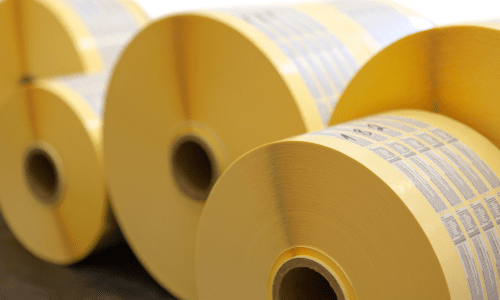Direct Thermal Labels vs. Thermal Transfer Labels
Comments Off on Direct Thermal Labels vs. Thermal Transfer Labels
There are multiple types of thermal labels, each relying on heat from a printhead to create images. However, slightly different processes are used to create each type. Direct thermal labels and thermal transfer labels and ribbons each feature unique characteristics and are used in different types of applications. When selecting a label for your application, it is important to know the strengths and limitations of each type to ensure your label effectively fulfills its purpose.
What Are Direct Thermal Labels?
Text and images on direct thermal labels are created by applying heat to the label’s surface which features a special surface coating that reacts to heat from a printhead. Images can be printed on direct thermal labels using heat alone.
Each type of thermal label features differing print quality, longevity, and durability. Both paper and synthetic materials are used as thermal facestocks to create labels. Paper labels can be coated or uncoated are best suited for indoor, short-term use. Synthetic materials, such as polyolefin, polyester, or polypropylene, do well in extreme temperature environments and can last up to several years, depending on the material.
Thermal labels have a wide variety of uses, from printing barcodes, receipts, shipping labels, and food packaging.
What Are Thermal Transfer Labels and Ribbons?
Thermal transfer labels are a widely used type of thermal label that features many benefits. In thermal transfer printing, a special ribbon is passed between the printhead and label to create the printed images. Thermal transfer ribbons are made from a thin film featuring a black coating on one side. The coating, typically made from a resin or wax, is heated by the printhead and transfers onto the label. Thermal labels and ribbons are available in many sizes and diameters. The ribbons are sold in wound rolls that come in many color options.
Key Features: Direct Thermal vs. Thermal Transfer Labels
Direct thermal labels and thermal transfer labels and ribbons are created differently, feature different characteristics, and are better suited to different uses and environments. Let’s take a closer look at the characteristics of each type.
Thermal Labels:
Thermal labels are useful for printing information on demand. Ingredients, dates, and barcodes are just some of the many uses for these labels. Direct thermal labels are typically used in short to medium-life applications, where they will not be exposed to moisture or heat after application. Direct thermal labels are highly cost-effective and create clear, consistent images that can be easily read and scanned.
In comparison to the longer-lasting thermal transfer labels, direct thermal labels can fade in as little as 6 to 12 months. They also do not stand up well to high levels of abrasion. However, they are well suited to applications such as shipping and logistics, price tags, meat labeling, and more.
Thermal Transfer Labels and Ribbons:
Thermal transfer labels and ribbons are useful for creating barcodes, QR codes, and sequential numbering applications. In comparison to direct thermal labels, they have the unique benefit of being chemically resistant. These labels can be exposed to substances ranging from water, oil, bleach, and even acetone due to the highly durable resin ribbon with which they are made. They are also resistant to UV light.
Thermal transfer labels and ribbons are well suited to long-life applications and are available in a large selection of materials to meet the demands of many environmental challenges. They can also be backed with an adhesive if required by the application.
Applications
Due to their inherent differences, direct thermal and thermal transfer labels are better suited for different applications.
Thermal Labels:
Direct thermal labels are best suited to industries that don’t involve exposure to high heat or moisture levels. They do well in chilled environments, such as labeling frozen foods, and are used throughout applications spanning many industries including:
- Event ticketing
- Coupons
- Healthcare industry applications, including visitor passes
- Name tags
- Barcodes for retail products and shipping labels
- Receipts
- GHS-compliant labels
Thermal Transfer Labels and Ribbons:
Thermal transfer synthetic labels perform well in outdoor applications as well as those featuring high moisture and abrasion exposure. They are an excellent choice when direct thermal labels are unsuitable or when high print quality is desired. They are used in applications such as:
- Creating high quality, long-lasting images
- Medical applications involving chemical exposure
- Warehouse shelf labels
- Chemical and industrial labels
- Laboratory labels
- Applications requiring color, such as for branding or promotional uses
FOCUSales: Your Source for All Label Solutions
FOCUSales stocks an extensive selection of direct thermal and thermal transfer labels and ribbons. We carry thermal transfer ribbons for all the leading thermal printer manufacturers, as well as hundreds of ribbon varieties. To learn more about our products or talk to an expert about finding the best solution for your application, contact us or request a quote today.
